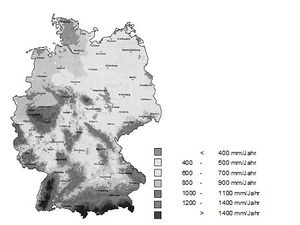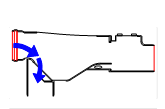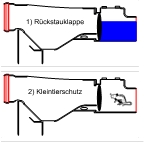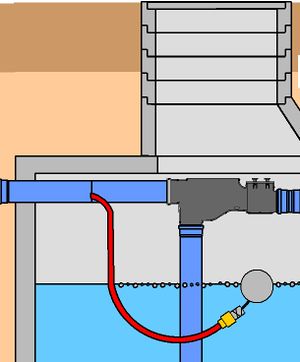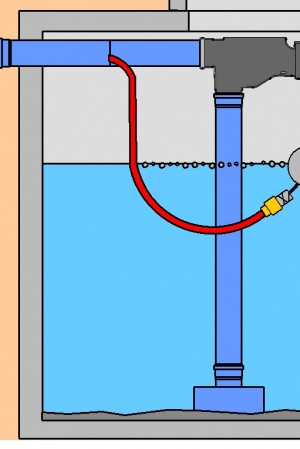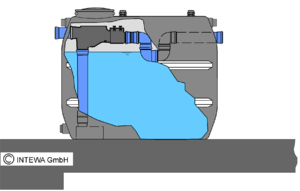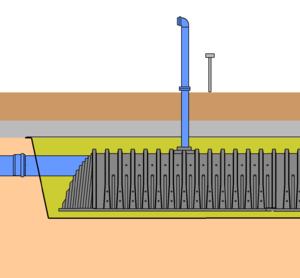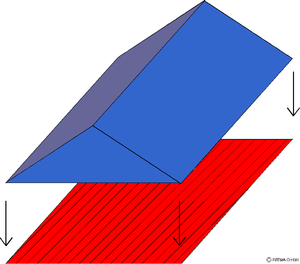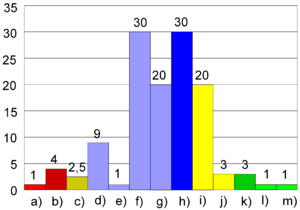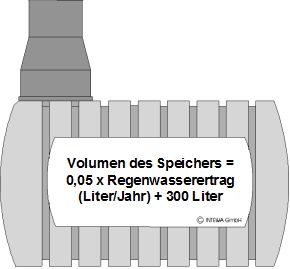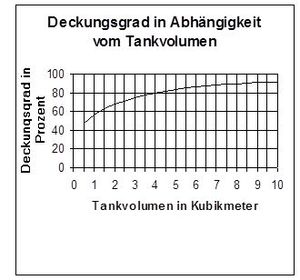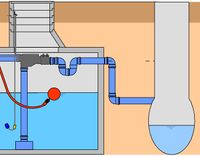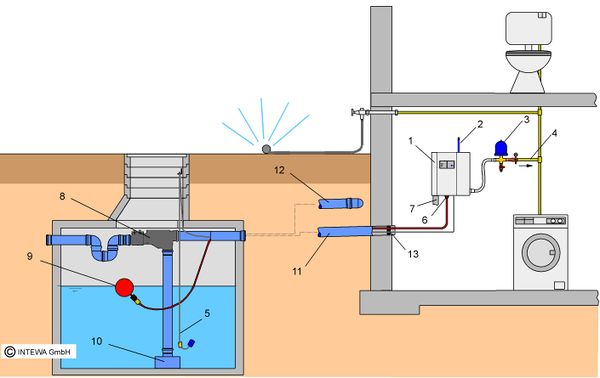Regenwassernutzung/en: Unterschied zwischen den Versionen
(Die Seite wurde neu angelegt: „====Storage overflow on a mixed water system under the backwater level or connected to higher infiltration drainage====“) |
|||
| Zeile 453: | Zeile 453: | ||
If the overflow is not connected on the drainage system with backflow prevention, then according to DIN1989-1 a [[#Self-cleaning fine filter|backflow preventor]] must be installed so that by backup no water will enter the cistern. | If the overflow is not connected on the drainage system with backflow prevention, then according to DIN1989-1 a [[#Self-cleaning fine filter|backflow preventor]] must be installed so that by backup no water will enter the cistern. | ||
| − | ==== | + | ====Storage overflow on a mixed water system under the backwater level or connected to higher infiltration drainage==== |
[[Datei:RWN Mischwassersystem.jpg |200px|miniatur|Regenwasserspeicher als Pumpschacht]] | [[Datei:RWN Mischwassersystem.jpg |200px|miniatur|Regenwasserspeicher als Pumpschacht]] | ||
Version vom 7. November 2018, 14:22 Uhr
According to the European Drinking Water Directive <ref name="Europäische Trinkwasserverordnung">European Drinking Water Directive</ref>water in households, which is not used for drinking or bodily hygiene, can be replaced with so-called non-potable water. This non-potable water can be relatively easily collected from roof runoff water. Roof runoff is rainwater that has come from roof surfaces. At minimum non-potable water can be used for toilet flushing, laundry washing or for irrigation purposes. In this way a savings-conscious household can save up to 50 L of drinking water per person every day. Considering the usage in Germany, this constitutes around 50% of the total usage.
With today’s technology, e.g. the PURAIN rainwater filter and AQUALOOP ultrafiltration and UV disinfection, the possibilities for using rainwater for new usages, i.e. with some treatment so that drinking water quality is achieved and can therefore be used for bodily hygiene or drinking water. The compliance and validation of the water quality is ordinarily the obligation of the individual operator.
Usage possibilities:
- Toilet flushing
- Garden irrigation
- Washing machines
- Showering
- Drinking
- Cleaning purposes
- Cooling
- Process water
Advantages for the end-user
- Savings from increasing drinking and wastewater fees
- Soft rainwater is optimal for irrigation of plants
- Reduction of laundry detergent up to 50%
- No hard water buildup in washing machines and softeners are unnecessary
- Soft rainwater protects clothing
- Low-ion rainwater reduces the incidence of kidney stones
- Independence from the water provider
- No anthropogenic trace substances and medical residues
Advantages for communities
- Expenditure reduction for flood protection and avoidance
- Cost reduction for sewer construction, renewal and operation of treatment plants
- Savings potential by connection costs for new construction areas
- Secure the groundwater reservoir and therefore the drinking water supply
Basic principles
Precipitation
The precipitation <ref name="WIKI">Wikipedia</ref> is the amount of flowing water (rainwater) that has been collected in a closed basin during a specific time span from precipitation (rain, snow, hail, fog, etc.). The information is measured in litres and is correlated to square meters.
The average yearly rainfall amount
Information on average rainfall values can be obtained from the online service of weather bureaus. The average rainfall amount, e.g. in Germany is about 830 mm / year. In alpine countries 2000 mm of precipitation is very common.
average annual precipitation <ref name="DW">Wetterkontor</ref> of selected areas in Germany in mm/year
| Location | mm/year | Location | mm/year | Location | mm/year | Location | mm/year |
|---|---|---|---|---|---|---|---|
| Aachen | 806 | Erfurt | 528 | Kassel | 696 | Neubrandenburg | 569 |
| Augsburg | 824 | Essen | 893 | Kempten | 1275 | Nuremberg | 627 |
| Bayreuth | 675 | Flensburg | 816 | Kiel | 752 | Passau | 934 |
| Berlin | 593 | Frankfurt/M. | 655 | Cologne | 804 | Regensburg | 643 |
| Bonn | 670 | Freiburg | 933 | Konstanz | 839 | Saarbrücken | 812 |
| Bremen | 713 | Gera | 608 | Leipzig | 586 | Schwerin | 625 |
| Chemnitz | 726 | Görlitz | 673 | Lübeck | 658 | Siegen | 1008 |
| Cottbus | 573 | Greifswald | 552 | Magdeburg | 521 | Stuttgart | 675 |
| Dortmund | 840 | Halle | 476 | Mainz | 587 | Uelzen | 616 |
| Dresden | 668 | Hamburg | 744 | Mannheim | 642 | Ulm | 744 |
| Düsseldorf | 757 | Hanover | 644 | Munich | 920 | Wittenberg | 576 |
| Emden | 778 | Karlsruhe | 740 | Münster | 747 | Würzburg | 597 |
Seasonal distribution of precipitation
In addition to the average amount of precipitation, the seasonal distribution of precipitation is an important input parameter for tank dimensioning.

Source <ref name="Wiki-media">commons Wikimedia</ref>
Peak precipitation of rain events
In addition to the average annual precipitation and the seasonal distribution the consideration of short-term rain events is important for optimal dimensioning, particularly for pipes, rainwater filters and rainwater retention systems. Heavy rain events that occur approximately 4 to 10 times in a year, hardly contribute to water yield in most regions. For instance, heavy rain events contribute only about 3% of the total water yield in Germany. By contrast, light rain events provide about 97% of the water quantity. This knowledge is particularly important for the selection of an appropriate filter system.
Evaluation of rainfall<ref name="Uni Siegen">Siegen Forschungsstelle Wasserwirtschaft fwu Universität Siegen</ref> data for the years 1993 to 1997 by Siegen Research Center for Water Management, Research Institute for Water and Environment, University of Siegen
| Rainfall | 1993 | 1994 | 1995 | 1996 | 1997 | Average | Total |
|---|---|---|---|---|---|---|---|
| mm/5min | % | % | % | % | % | % | % |
| 0.1 | 64.11 | 64.03 | 67.74 | 69.47 | 68.25 | 66.72 | 66.7 |
| 0.2 | 19.78 | 20.93 | 18.40 | 16.93 | 18.94 | 18.99 | 85.7 |
| 0.3 | 8.24 | 8.64 | 7.39 | 6.84 | 6.51 | 7.52 | 93.2 |
| 0.4 | 3.55 | 2.7 | 2.96 | 2.84 | 2.74 | 2.96 | 96.2 |
The table shows that more than 96% of rainfall occurs with an intensity of up to 0.4 mm / 5 min. With a roof area of 150 m², a rainfall of 0.4 mm / 5 min corresponds to an inflow of 0.2 L / s maximum.
This precipitation characteristic, that light rain events deliver > 96% of the rainfall amount – is similar worldwide. Also refer to the values of heavy precipitation values for the USA
Catchment areas
The rainwater yield depends on the size and type of the connected roof surfaces and the precipitation amount. If possible, all existing sealed surfaces and roof areas should be connected to achieve the highest possible yield. Different types of roofing materials differ in both their flow characteristics as well as in the potential contamination of the gathered water gathered.
House and garage roofs are the most suitable catchment areas for rainwater harvesting. Particularly suited are the roofs with smooth surfaces such as tiles, slate or glass. Tile and slate roofs also increase the pH value of acidic rain.
Courtyard or parking areas With connection to courtyard or parking areas additional preliminary cleaning must be done depending on the accumulation of pollutants and separators may be required in case of risk of oil contamination.
Green roofs offer a significantly lower yield due to their natural retention effect. Here particular attention must be paid to the organic load and water discolouration. With a reasonable yield and professional construction, green roofs are quite suitable as collection areas.
Bitumen roofs cause, as with all new roofs, in the beginning a yellow discolouration in the captured rainwater. In order to prevent this colour in laundry, for the first months at least, the washing machine should not be connected.
Asbestos cement roofs The asbestos cement roof must be refurbished before the water is used for example for garden irrigation, in order to avoid the danger of loose asbestos fibres.
Metal roofs Copper, zinc and lead, depending on the runoff concentration, are not suitable for irrigating crop plants. If in doubt, a water sample should be tested. This water can be readily used however without problem for watering ornamental plants, toilet flushing and for washing machines.
Components of a rainwater harvesting system
Filtration
See also Online Planner
With the following measures a good non-potable water quality can be achieved from rainwater:
- Self-cleaning fine filter
- Protection from backwater and small animals
- Skimmer overflow
- Floating suction filter
- Disinfection
- Sedimentation and biological cleaning
- Storage
If the water needs to reach drinking water quality, further treatment steps are required such as ultrafiltration and UV disinfection.
Self-cleaning fine filter
A self-cleaning, fine filter is today recognized as an important component of modern rainwater harvesting. Best results are obtained with a sieve width of about 0.8 mm. Entry of contaminants into the rainwater storage and maintenance intervals are minimized. Particular care should be taken that the sieve used is arranged in a trough, as demonstrated by the test results of some rainwater filters. There are self-cleaning rainwater filters on the market, with which about 50% of the precious water discards into the overflow, a catastrophic loss!
Collecting
It is especially important to make sure that light precipitation, which provides 97 % of water quantity, is 100% collected. With a PURAIN filter for instance, this takes place in a single collection area. Only in this way can an effective overall efficiency of > 98% be achieved. In filters without such a collection area, light precipitation always flows though the same sieve area. As a result the area quickly becomes clogged and further light rain precipitation flows into the overflow.
Self-cleaning
Heavy rain events are suitably used for self-cleaning (discharge of leaves, etc. from the collection area). Heavy precipitation events, which occur about 4 to 10 times a year (Germany) and contribute only approximately 3% of the total water yield, clean out the collection areas of for instance the PURAIN filter using turbulence, the so-called "hydraulic jump".
Protection from backwater and small animals
Clean water does not mean only to clean flowing rainwater, but also to assure that no pollution or small animals from the drainage system can enter the storage through the overflow. This is easily ensured by a non-return valve. Some filters, such as the PURAIN 100 already include these. In some countries such as Germany, the non-return valve is a requirement of the standard (DIN 1989 Part 1 prescribed non-return valve for connection of overflow to a separate system).
Skimmer overflow
An overflow skimmer removes with every storage overflow the floating surface contaminants and automatically transports them to the polluted water discharge. This is a sensible and practical measure to easily and regularly remove grease, pollen, etc. from the storage. The skimmer is already integrated in the PURAIN 100 filter.
Floating suction filter
Floating extraction with suction filtration ensures that the pump always draws the cleanest water from the storage. If however, coarse particles entered the tank, then the floating extraction retains them and protects the pump. The suction filter should not be too fine-meshed to prevent blocking by biofouling. This blocking can rapidly develop to defects in the pump. The ideal mesh size of the suction filter is around 1 mm.
Fine filter
By using the described filtration and cleaning techniques, the use of fine filters with mesh openings < 0.8 mm for toilets, washing machines and irrigation is redundant.
Finer filters may be needed for special requirements with process water. Then such a filter is to be installed on the pressure side behind the pump. During operation it is important to pay attention to regular maintenance as fine filters retain dirt. They should be opaque and care should be taken to ensure simple maintenance with provided stopcocks and ventilation.
Disinfection
See INTEWA WIKI guidelines for [Wasseraufbereitung_und_Grauwassernutzung/en|water treatment and greywater recycling]
Sedimentation
The inflowing water may still contain fine substances, which are not retained by the filter. These sedimentation constituents gradually settle down on the bottom of the storage with time, where some additional biological self-cleaning effects are active. To avoid dispersion of the accruing sedimentation layer, the inflow into the cistern should be done through an inlet calmer.
Storage of water
In order to ensure optimal water quality proper storage of the rainwater plays a deciding role. The water is best stored cool and protected from light to prevent as little algae and bacterial growth as possible. Further the storage must be frost-protected.
The storage has a special importance in rainwater harvesting simply due to the construction size. In tropical countries with daily precipitation a tank with only a few hundred litres covers the daily needs of a single-family house. In some areas of Spain there are cisterns today with several hundred m³ of volume in order to last through prolonged dry-periods. When precipitation events are in general uniformly distributed throughout the year (e.g. Germany) and correspond well to the needs of the users, then the useful storage volumes are much smaller than often assumed. In order to determine a useful storage volume information about the quantity and distribution of precipitation as well as the needs is required. Attention must be given to continuing climate change which is resulting in longer dry-periods and accordingly larger required storage volumes.
Generally the following storage types are distinguished:
Above-ground tank
Freely erectable, above-ground tanks can be assembled in the garden, basement or on the roof of a house. They are often used when there is no possibility for underground installation of a tank, such as retrofitting in rocky ground or too narrow construction areas.
The tank must be statically dimensioned in such a way that it can withstand the water pressure permanently without deformation. "Note:" Most underground tanks cannot be freely erected.
Furthermore, it is important that these tanks are absolutely opaque to prevent biological growth. Freely erectable above-ground tanks are made of several materials, the most common of which are PE, PP, GRP, concrete, coated metals, but also wood and clay.
Underground tank
They are suitable for many new buildings if excavation has already been done. They can be housed under parking areas or driveways to save space.
Underground tanks must be dimensioned for decades of useful life and for soil and traffic loads. Underground tanks are made of several materials, the most common of which are PE, PP, GRP, and concrete.
PE or HDPE plastic tank
Plastic tanks are produced by various manufacturing processes. The most common method is called rotational moulding through which PE (recyclable polyethylene) is melted in a hollow form, rotated and cooled. After demoulding, the hollow body (tank) is obtained. Since the machinery costs are not particularly high, several different shapes are available on the market. The stability and quality of the storage is determined by the suitable shape, wall thickness and ribbed-structure. Most of these tanks are offered in the walkable design (no traffic loads) and with volumes from 1000 to max. 10,000 litres suitable for single-family houses. In order to obtain greater storage volumes, several tanks can be coupled together. Their low weight makes transportation cheaper than concrete tanks and easy placement in the excavation pit without a crane. Most underground plastic tanks are not suitable for high groundwater levels or cohesive soils (clay). The uniform filling and compaction with a suitable filling material for plastic tanks is a prerequisite to achieve the necessary stability.
GRP tank (glass-reinforced plastic)
Glass-reinforced plastic tanks are recommended for large storage volumes up to about 250 m³ mostly in the commercial sector. They can be made of one piece. Production is relatively flexible, so that requirements of larger construction projects can be catered to, for example heavy loads of up to SLW60 (60 t truck trafficability), flexible connection choices, integration of additional manhole shafts, fittings, pipes, internal partitions etc. These tanks are also suited as retention tanks or fire-fighting water tanks.
Concrete tank
Several concrete factories now produce monolithic concrete tanks (without junctions in water area) for rainwater harvesting in sizes of up to 20 m³. Due to the weight of tanks and the corresponding high transportation costs on special trucks with rear-mounted cranes, they are usually used within a range of a few 100 km around the production factory. Since the tanks can be directly installed in the excavation pit most suitably by the rear crane, it must be well accessible by the truck. Most concrete tanks are usually trafficable by passenger cars and with the appropriate cover even by trucks. With appropriate soil cover, the concrete tank can also be used with high groundwater. Cohesive soils are usually unproblematic. Larger volumes can be realized by coupling multiple tanks or with in-situ concrete construction. The quality of a concrete cistern is determined by the concrete quality (e.g. compressive strength class C45/55), the concrete reinforcement (steel reinforcement at least in the base and cover) and wall thickness (min. 8 cm).
Former oil and septic tanks
Sometimes even former septic tanks or old oil tanks can be retrofitted for rainwater storage. The old tanks should still be in good condition otherwise the retrofit is more expensive and elaborate than using a new tank. A coating for a steel tank can quickly become more expensive than a new rainwater tank.
Tunnel system
If special designs and sizes are requested for rainwater storage, then it may be appropriate to use plastic elements for rainwater infiltration and retention. DRAINMAX tunnel elements for instance can be installed in an enclosed sheet basin. The storage volume is then made up of the void volume in the backfill material and the storage volume of the tunnel.
Planning and dimensioning
For dimensioning a rainwater harvesting system, the following Online Tools are very helpful:
Dimensioning cisterns
For larger projects, perform a calculation for optimal storage sizes utilizing long-term rain data with the Rainplaner Software.
In order to calculate the optimal storage size, the relationship between rainwater yield and non-potable water requirement needs to be determined.
Rainwater yield
For a rough calculation that is enough for most storage size dimensioning, the following calculation is reliable for an average yearly rainwater yield:
| Rainwater yield = roof area x precipitation amount x runoff coefficient x filter efficiency |
|---|
Roof area: The roof area includes the projected roof area in m² including all overhangs.
Precipitation amount: The average annual precipitation in mm/year is shown in the overview map. More detailed information can be obtained from the respective weather bureau.
Runoff coefficient: The runoff coefficient determines the proportion of rainfall from the total precipitation that is actually released by the roof. Described here is a very simplified simulation of the retention in different roofing materials, which have been tested in practice.
Runoff coefficients for different roof materials according to DIN 1989 Part 1:
| Roof material | Runoff coefficient |
|---|---|
| Pitched hard roof | 0.8 |
| Gravel / non-gravel flat roof | 0.6 / 0.8 |
| Intensive / extensive green roof | 0.3 / 0.5 |
Filter efficiency: An effective filter efficiency around 0.98 is calculated with use of a PURAIN filter.
Example 1
| Calculation of rainwater yield |
|---|
| * Single-family house with 100 m² roof area and clay-brick roof |
| * Annual precipitation = 750 mm/year |
| * Runoff coefficient = 0.8 |
| * Filter efficiency = 0.98 |
| =>Rainwater yield = 100 m² x 750 mm/year x 0.8 x 0.98 x 10-3 = 59 m³/year |
Non-potable water requirement
Quelle <ref name="Uni OL">DIN 1989-1</ref>
The non-potable requirement depends on the connected fixtures and their usage. Some average values are summarized in the table below for the requirement per person and day:
| Daily average consumption / person | ||
|---|---|---|
| House | Toilet flushing | 30 litres |
| Washing machine | 10 litres | |
| Garden irrigation | 60 L/m² year | |
| Cleaning purposes | 6 litres | |
| Showering, bathing, hand washing | 59 litres | |
| Drinking water | 1 litre | |
| Office building | Cleaning purposes | |
| Toilet flushing | 12 litres | |
| School / sports hall | Toilet flushing | 6 litres |
| Sprinkler system | 200 L/m² |
Example 2
| Calculation of non-potable water requirement | ||
|---|---|---|
| * * daily requirement of non-potable water in a 4-person household: | ||
| * Toilet flushing | 30 litres / person x 4 people = | 120 litres |
| * Washing machine | 10 litres / person x 4 people = | 40 litres |
| * Garden irrigation | 1 litre / person x 4 people = | 4 litres |
| => Total non-potable water requirement per day: | 164 litres | |
| => Annual requirement: | 164 litres/day x 365 days = | 60 m³ |
When compared with the rainwater yield of 59 m³ determined in Example 1 for a single-family house, it is seen that almost the total requirement of the toilet, washing machine and garden can be covered by the average rainwater yield.
Tank sizes
Yield = Requirement
If the rainwater yield covers the non-potable water requirement, then an easy dimensioning value of 5% of the average yearly rainwater yield is reliable. In the image attention must be paid to the non-used portion of the tank (e.g. 300 litres in a 3000 litre tank) found between the tank bottom and the suction inlet.
Yield << Requirement
Tanks with smaller dimensions are preferred when the rainwater yield is permanently much lower than the non-potable water requirement. In this case, a tank volume of 3% of the average annual rainwater yield is sufficient. If there is low yield, then it should be initially checked whether other roof areas (e.g. neighbouring buildings) can be connected to the system. If this is not possible, then it may be appropriate to connect only some of the consumption points to rainwater harvesting to reduce the necessary drinking water backup.
Yield >> Requirement
In this situation the dimensioning primarily aligns itself along the non-potable water requirement and can with around 5% of the yearly requirement roughly estimated.
Example 3
| Determination of the required storage volume for a single-family house. | |
|---|---|
| The data for this example is taken from Example 1 and Example 2. | |
| * Roof area (brick): | 100 m² |
| * Yearly precipitation: | 750 mm |
| * Runoff coefficient incl. filter efficiency: | 78.4 % |
| => Rainwater yield: | 59 m³/year |
| Number of users: | 4 people |
| Connected fixtures: | Toilet, Washing machine, garden irrigation |
| =>Non-potable water requirement: | 60 m³/year |
| * The dimensioning of the storage volume follows the 5% rule: | |
| Storage volume: 0.05 x 59 m³ + 300 L = | 3.25m³ |
Storage simulation with software
Larger construction projects and commercial non-potable water usage should have a more specific requirement analysis done, e.g. the influences of seasonal variations, vacation periods, etc. Here for example the simulation software RAINPLANER can be utilized.
Instead of using average precipitation values, actual rain events for every day are considered. Furthermore, the runoff retentions of different roof materials as well as the overflows of the storage during heavy rain events are specifically modelled.
In the displayed trend line, the seasonal variations are identified. In optimal situations during the entire year the water level stays at an average value. A few storage overflows during the year are not a problem as they remove surface contaminants from the water surface.
Economical storage volume
Simulations, varying precipitation amounts and the amount of overflow water considered prove that the storage should not be chosen as too large. The coverage ratio in the figure describes the portion of non-potable water requirement that can be covered by rainwater. For Example 3 this ratio is displayed in the graphic as dependent on the storage volume. The maximal possible targeted coverage ratio is 94 %. To achieve this value, an exceedingly large tank would be needed. In practice, a tank with 3.5 m³ would be installed that can almost cover 80 % of the non-potable water requirement with rainwater. An unnecessary enlargement of the storage volume would increase the investment costs.
In order to guarantee that even in dry years the surface contaminants are washed away 3 to 5 times in the overflow the storage should not be chosen as too large.
Pure irrigation is something else entirely. Here it can make sense and is wished that rainwater during rainy periods is collected for use during dry times. This leads to a much larger storage volume.
Similarly, this is also in regions with defined dry and rainy seasons. If the total water needs for the dry season were to be collected in the rainy season, the rainwater storage would have to be around 6-times as big. Alternatively, thought can be given to only using the rainwater system during the rainy season based on economic reasons since a much smaller storage could be operated.
Installation instructions for rainwater tanks
It is important to determine the heights of the connections and installation depth for the cistern and execution of the groundwork. The necessary connection sizes of the tanks are taken from the technical product sheets. The discharge pipe must be laid below the frost-zone (in many regions in Germany e.g. 80 cm) with a 1% grade.
The installation depth is determined as follows:
| Frost depth pipe installation F | e.g. 80 cm |
| + necessary pipe grade G | e.g. 10 cm |
| + inlet height on tank Z | e.g. 162 cm |
| = installation depth of the tank E | e.g. 252 cm |
According to the ground considerations approximately 10 cm should be excavated to prepare the subsurface for the placement of the cistern.
High ground water level
With higher ground water levels only specially-designed cisterns can be used. Additionally a calculation of the flotation potential must be made. Many concrete tanks can be placed in ground water without additional flotation prevention due to their own weight and ground cover. Additional flotation prevention can be introduced e.g. with ground anchors.
Entry opening
The entry opening to the storage must be kept free for later cleaning and maintenance work. To adjust to the ground level extendable dome shafts or concrete compensation rings can be used. To avoid accidents the entry must be secured with a locking lid or be so heavy that small children cannot open it.
Storage overflow and backwater level
The height of the storage overflow is designed according to the connections oft he cistern. The storage overflow can be connected to the following drainage facilities:
- Infiltration systems
- Stormwater sewers in separated systems
- Mixed water systems
Where possible the storage overflow should be connected to infiltration so that overflowing water refills the on-site ground water. If no infiltration is provided then a sewer connection is necessary for the overflow. If a separated system is provided the rainwater is fed to the stormwater sewer. Otherwise it should be connected to the mixed water network.
Rarely occurring heavy rainfall events can result in an overload of the respective drainage. The accumulated water cannot be properly released and a backup of water in the cistern occurs. Because of the possible repercussions on the storage, special attention must be made when designing a rainwater system for this situation. It must, in particular with connection to a mixed water system, that contaminated water is prevented from flowing from the sewer network to the storage.
The backwater level shows to which height water from the sewer network can be backed up to. The height of the backwater level is usually determined by the local authority. Otherwise, it is usually the same as the upper level of the road surface (DIN 1986).
Storage overflow above the backwater level
In very few cases the overflow will be above the backwater level. In this situation the overflow water can be directed straight to sewer with the given grade. Here the overflow must lie at minimum 20 cm above the backwater level. The overflow must be below the inlet pipework with a larger or same diameter as the inlet pipe.
Storage overflow under the backwater level of the stormwater sewer or infiltration system
If the overflow is not connected on the drainage system with backflow prevention, then according to DIN1989-1 a backflow preventor must be installed so that by backup no water will enter the cistern.
Storage overflow on a mixed water system under the backwater level or connected to higher infiltration drainage
Vorgabe nach Norm DIN1989-1
Bei einem Anschluss des Speicherüberlaufes an einen Mischwasserkanal oder an eine höher liegende Versickerungseinrichtung sollte nach DIN1989-1 eine Hebeanlage zum Einsatz kommen. Mit einer Hebeanlage wird das Wasser bei Erreichen des maximalen Wasserstandes durch eine Tauchpumpe über die Rückstauebene gefördert. Es ist darauf zu achten, dass die Druckleitung auch im Bereich der erhöhten Rückstauschleife frostsicher verlegt ist. Die Rückstauschleife kann dazu auch im Haus verlegt sein. Die Dimensionierung der Pumpe erfolgt nach DIN 1986-100 mit r(5,100). Die Pumpe kann dabei im Regenwasserspeicher untergebracht werden, wodurch ein zusätzlicher Pumpschacht entfällt.
Ausführung in der Praxis
Wogegen beim Anschluss an die höher gelegene Versickerung und Retention eine Hebeanlage auch technisch unbedingt erforderlich ist, ist mit dem Kunden bei Anschluss an das Mischwassersystem abzusprechen, ob nicht doch die Installation einer einfachen Rückstauklappe ausreichend ist. Das Risiko einer fäkalen Verschmutzung durch Rückstau aus dem Mischwasserkanal kann relativiert werden, da in der Regel die Zisterne ohnehin voll Wasser steht, wenn es zu einem Überlaufen des Kanalsystems kommt. Weiterhin sind die Verschmutzungen bei diesen Regenereignissen sehr stark verdünnt.
In der Praxis werden solche Hebeanlagen fast nie verwendet.
Ebenso verhält es sich mit der Dimensionierung der Hebeanlage, da bei der Berechnung nach DIN 1986-100 mit r(5,100) sehr große Volumenströme errechnet werden. Die Volumenströme können reduziert werden, wenn ein zusätzliches Puffervolumen geschaffen wird, um das maßgebende Starkregenereignis zu reduzieren.
Erforderliche Tauchmotorpumpenleistung bei Einsatz als Hebeanlage im Regenwasserspeicher am Beispiel der Starkniederschlagsreihen von Köln mit und ohne Puffervolumen:
| Regenspende r5, 100 = 648,5 l/(s-ha) Dachfläche A = 100 m² | |||
|---|---|---|---|
| V = 0 | V = 1 m³ | ||
| Pumpenleistung [l/min] | Pumpentyp | Pumpenleistung [l/min | Pumpentyp |
| 389 | BIOX 400/12 | 195 | DRENOX 250/10 |
Die Pumpenempfehlung berücksichtigt eine Gesamtförderhöhe (Hgeo + HVerlust) von max. 2 m.
Sowohl Hebeanlagen als auch Rückstauklappen unterliegen im Betrieb der Wartungspflicht und müssen daher über Revisionsöffnungen zugänglich gehalten werden. Außerdem ist der Fall zu beachten, dass wegen eines Pumpendefekts oder anstehendem Rückstau kein Wasser aus dem Speicher abgeführt werden kann, obwohl weiter Wasser zuläuft. Bei Außenzisternen ist dann ausnahmsweise ein unkontrollierter Wasseraustritt aus einem Notüberlauf, welcher im Zisternendeckel sein kann, zu akzeptieren. Ein Eindringen des Wassers in das Gebäude z.B. über das Leerrohr muss jedoch sicher ausgeschlossen werden.
Pumpen, Betriebs- und Regenwasserwerke
Für die Dimensionierung einer Betriebswasserpumpe ist folgendes Online Tool hilfreich:
Leitungsnetz und Zubehör
Auf seinem Weg zum Verbraucher durchläuft das Regenwasser unterschiedliche Leitungen. Die Versorgung der Entnahmestellen einer Regenwassernutzungsanlage erfolgt über ein eigenes sogenanntes Betriebswassernetz. Das Betriebswassernetz muss aus korrosionsbeständigen, lichtundurchlässigen Materialien bestehen. Die Saugleitung zur Pumpe sollte, um Undichtigkeiten vorzubeugen, in einem Stück verlegt werden. Optimal ist der Einsatz von hochwertigem, knickfestem EPDM Gummimaterial (PVC-Schlauch ist aufgrund der Weichmacher nicht geeignet!). Er kann sich beim Ansaugen der Pumpe nicht zusammenziehen, gewährleistet aber trotzdem durch seine Flexibilität die schwimmende Entnahme und eine einfache Verlegung durch ein Leerrohr. Bei Unterwassermotorpumpen dämpft ein EPDM Druckschlauch zudem die Druckstöße beim Einschalten der Pumpe ab. Bei Saugpumpen ist zur Isolierung als Übergang zwischen Pumpe und starrem Betriebswasserleitungssystem ein Panzerschlauch einzusetzen. Bei besonders schnellschließenden Verbrauchern oder ungünstig verlegten Leitungssystemen kann zwischen Verbraucher und Steuereinheit ein Ausdehnungsgefäß erforderlich werden.
Leitungen und Leerrohre sollten zum Haus hin mittels einer Mauerdurchführung sicher abgedichtet werden.
| 1. Regenwasserwerk RAINMASTER Eco | 8. Regenwasserfilter PURAIN |
| 2. Trinkwasseranschluss | 9. schwimmende Ansaugfilterung |
| 3. Druckanschlussset mit Ausdehnungsgefäß | 10. Zulaufberuhigung |
| 4. Druckleitung zu den Verbrauchern | 11. Schutzrohr für Saugleitung und Sensorkabel |
| 5. Schwimmschalter | 12. Regenwasserzuleitung |
| 6. Saugleitung | 13. Mauerdurchführung MD-100 |
| 7. Notüberlauf |
Rechtliches
Bei der Installation einer Regenwassernutzungsanlage sind einige Vorschriften zu beachten. Hier sind die Deutschen Richtlinien und Normen aufgezeigt.
DIN- und internationale Normen:
| Regelungsbereich | Regelwerk | Inhalt |
|---|---|---|
| Wasserversorgung | DIN 1989 | Norm für Regenwassernutzungsanlagen |
| DIN 1989 Teil 1 | Planung, Ausführung, Betrieb und Wartung | |
| DIN 1989 Teil 2 | Regenwasserfilter | |
| DIN 1989 Teil 3 | Regenwasserspeicher | |
| DIN 1989 Teil 4 | Bauteile zur Steuerung und Überwachung | |
| DIN EN1717 | Schutz des Trinkwassers vor Verunreinigung ... | |
| DIN 4034 Teil 1 | Schächte aus Beton | |
| DIN 1986-100 | Restnorm: Entwässerungsanlagen für Gebäude und Grundstücke | |
| DIN EN 12056 | Entwässerung innerhalb von Gebäuden ... | |
| DIN EN 752 | Entwässerung außerhalb von Gebäuden ... | |
| ARCSA/ASPE/ANSI 63-2013 | Rainwater Catchment Systems |
Anzeige- und Genehmigungspflichten:
| Regelungsbereich | Regelwerk | Inhalt |
|---|---|---|
| Baugenehmigung | Landesbauordnung | I.d.R. werden Zisternen in der gängigen Größe für Ein- und Zweifamilienhäuser nicht als genehmigungspflichtig angesehen. Eine Darstellung des Anteils der Regenwasseranlage an der Grundstücksentwässerung im Rahmen des Entwässerungsgesuchs reicht aus. Die Nutzung von vorhandenen Behältern als Regenwasserspeicher bedarf einer Genehmigung |
| Wasserversorgung | AVBWasserV §3 | Antrag auf Teilbefreiung vom Anschluss- und Benutzungszwang + Anzeigepflicht vor Errichtung der Anlage beim kommunalen Wasserversorger |
| AVBWasserV §14 | kommunaler Wasserversorger ist berechtigt, Kundenanlage nach ihrer Inbetriebnahme zu überprüfen | |
| Trinkwasserverordnung | Mitteilungspflicht an das Gesundheitsamt bei Inbetriebnahme, Stilllegung oder baulichen Veränderungen Kennzeichnungspflicht der Betriebswasserleitungen, strikte Trennung von Trink- und Betriebswassernetz. | |
| örtliche Trinkwassersatzung | evtl. Anzeigepflicht bei Inbetriebnahme der Anlage |
Die Aussagen zu Anzeige- und Genehmigungspflichten sind als Regelwerte anzusehen. Einzelheiten sind bei den entsprechenden Behörden zu erfragen.
Quellen
<references />
